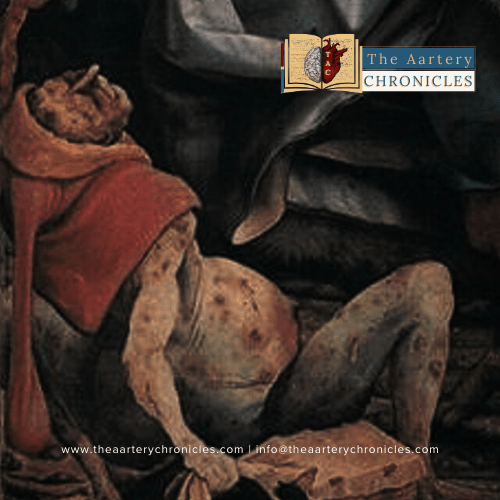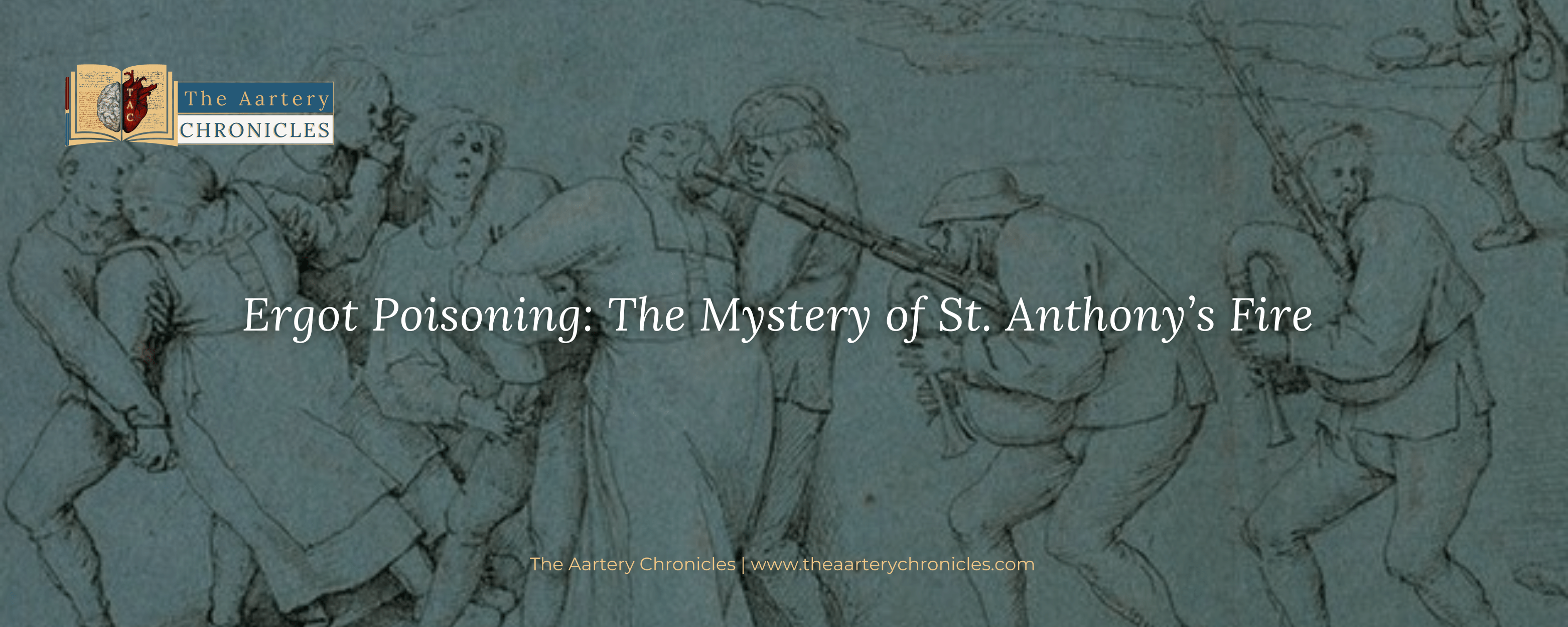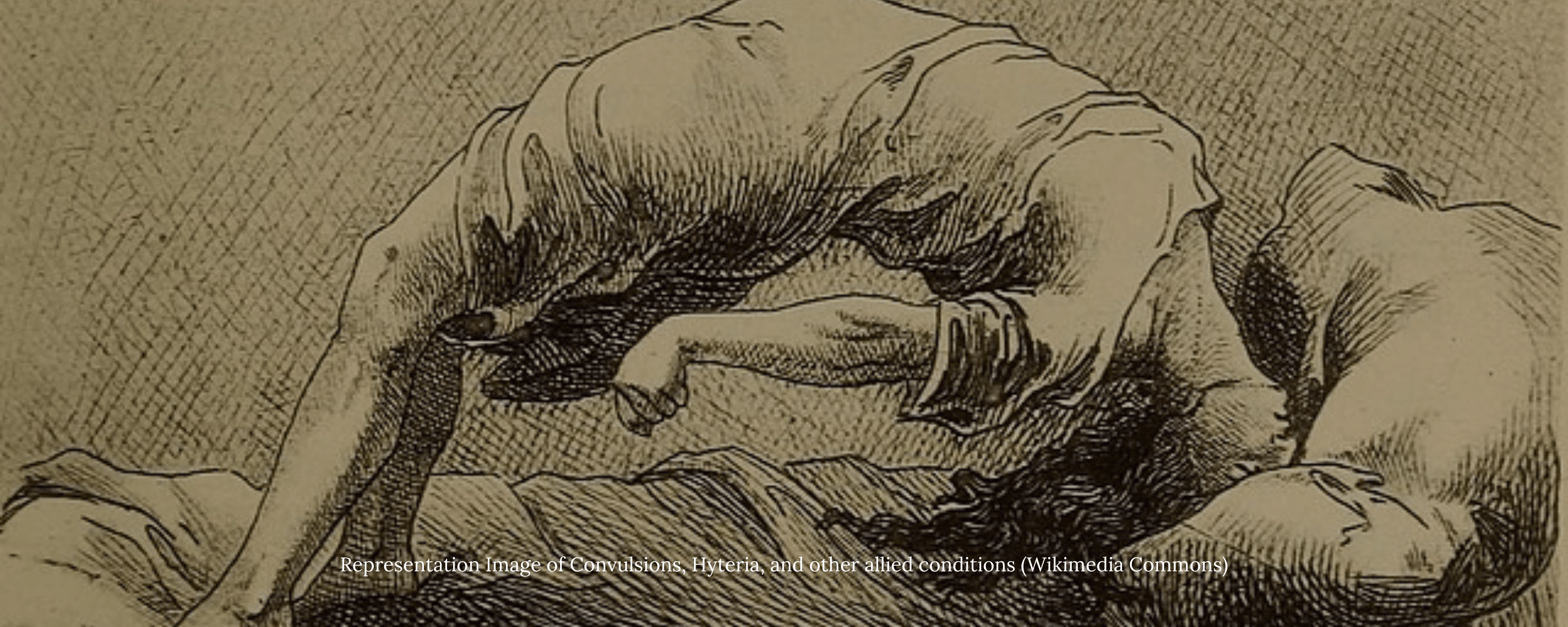

Ergot Poisoning and Ergotism: The Mystery of St. Anthony's Fire
Introduction
St. Anthony’s Fire, also known as ergotism, is a historical illness that has left a lasting mark on humanity’s understanding of fungal toxins and their devastating consequences. This article delves into the history, causes, symptoms, diagnosis, treatment, and intriguing facts surrounding ergot poisoning, shedding light on a once mysterious affliction that plagued medieval societies.
History
St. Anthony’s Fire, or SAF, owes its name to the excruciating burning pain experienced by those afflicted with gangrene caused by ergot poisoning. This illness emerged due to the ingestion of rye grain contaminated by a fungus known as Claviceps purpurea, which produces ergot alkaloids. The common name of the disease can be attributed to the medieval Benedictine monks dedicated to St. Anthony, who provided care to sufferers and sometimes used relics of the saint in their treatments. While SAF may not be as well-known as the Black Death, it was a constant presence throughout the Middle Ages. Although no precise figures exist to estimate the total casualties of SAF, a single outbreak in France in 994 CE resulted in a staggering 20,000 to 40,000 deaths.

About Poison
Ergotism, the condition arising from ergot poisoning, is primarily caused by the consumption of rye grain contaminated with the ergot fungus. This fungus, Claviceps purpurea, thrives on rye, a staple ingredient in bread production. The link between ergot fungus and rye grain poisoning was not established until 1596 CE when German physician Wendelin Thelius made the connection. However, the fungus was not entirely unknown, as in 1582 CE, another German doctor, Adam Loncier, described the use of small doses of ergot to induce strong contractions during labour in pregnant women.
Where it is found
Ergotism is primarily found in regions where rye is a dietary staple, particularly in Europe during the Middle Ages. The outbreaks of ergot poisoning were closely associated with the increasing cultivation of rye grain and the greater consumption of contaminated rye flour.

Signs and Symptoms of Ergotism
Ergotism presents two main characteristics, depending on the type:
- Gangrene (Chronic Ergotism): In cases of chronic ergotism, individuals experience the development of gangrene. This condition is characterized by restricted blood flow to the extremities, leading to intense burning sensations. In later stages, gangrene sets in, causing the detachment of fingers, toes, hands, and feet from the body.
- Convulsions (Acute Ergotism): Acute ergotism is marked by convulsions. The chemical composition of ergot poisoning often induces symptoms that may appear as if the affected person is “crazy.”
Additional symptoms of ergotism may include hallucinations, agitation, sores, muscle cramps, nausea, insomnia, and convulsions. These symptoms often led to confusion with other illnesses, such as the bubonic plague.
Differentials of ergotism
Ergotism, with its diverse range of symptoms, was frequently mistaken for other diseases during the Middle Ages. The most common misdiagnosis was the bubonic plague due to the initial symptoms’ similarity. Additionally, the dancing epidemics, also known as dancing plagues or tarantism, which occurred between the 14th and 17th centuries CE, were sometimes attributed to ergot poisoning. These dances, characterized by involuntary movements, could last for months and were linked to various factors, including ergotism, vengeful spirits, supernatural fears, tarantula or scorpion bites, and the hardships of everyday life combined with natural disasters.
Diagnosis of ergotism
In medieval times, diagnosing ergotism was a challenge due to the lack of medical knowledge and understanding of fungal toxins. Misdiagnosis was common, and it was only in later centuries that physicians like Wendelin Thelius made the connection between ergot fungus and the disease. Today, diagnosis relies on clinical presentation, medical history, and laboratory tests to detect ergot alkaloids in the patient’s system.
Treatment of ergotism
During medieval times, treatments for ergotism were often ineffective and based on superstition. Monks dedicated to St. Anthony sometimes employed relics of the saint in their attempts to alleviate suffering. Treatment options for ergot poisoning (ergotism) involve addressing the symptoms and countering the effects of ergot alkaloids, which are the toxic compounds produced by the Claviceps purpurea fungus. Prompt medical intervention is crucial to prevent the progression of the condition and alleviate the symptoms. Treatment strategies include:
The first step in treating ergot poisoning is to cease further exposure to the contaminated source, typically rye grain or rye flour. This prevents the intake of additional ergot alkaloids.
Activated charcoal may be administered to help absorb any remaining ergot alkaloids in the gastrointestinal tract. This can limit further absorption of the toxins.
To counteract the vasoconstrictive effects of ergot alkaloids, vasodilator medications may be used. These medications help improve blood flow to the extremities, reducing the risk of gangrene. Common vasodilators include calcium channel blockers and nitroglycerin.
Pain management is essential, especially in cases of chronic ergotism where gangrene and severe burning sensations occur. Analgesic medications, such as opioids, may be prescribed to alleviate pain.
Inflammation can exacerbate the symptoms of ergotism. Nonsteroidal anti-inflammatory drugs (NSAIDs) or corticosteroids may be used to reduce inflammation and relieve discomfort.
Patients with ergot poisoning may require supportive care to address specific symptoms. This may include wound care for individuals with gangrene, treatment for seizures in cases of acute ergotism, and hydration for those experiencing nausea and vomiting.
In severe cases of gangrene where tissue damage is extensive, surgical intervention may be necessary. This could involve amputation of affected limbs to prevent the spread of gangrene and save the patient's life.
In some cases, antidote medications such as ergotamine tartrate or dihydroergotamine may be administered to counteract the effects of ergot alkaloids. These medications work by blocking the receptors that ergot alkaloids bind to, reducing their impact.
Ergotism can lead to hallucinations, agitation, and psychiatric symptoms. In such cases, psychiatric support and medications may be necessary to manage these symptoms.
Continuous monitoring of the patient's condition is vital, especially in cases of acute ergotism. Close observation allows healthcare providers to assess the effectiveness of treatment and adjust it as needed.
It’s important to note that the specific treatment approach may vary based on the severity of the poisoning, the symptoms presented, and the patient’s overall health. Early diagnosis and intervention are crucial for a better prognosis. If ergot poisoning is suspected, individuals should seek immediate medical attention to receive appropriate treatment and prevent further complications.
Interesting Facts about ergotism
- Dancing Epidemics: Ergotism may have contributed to the mysterious dancing epidemics witnessed in medieval Europe, where groups of people engaged in involuntary, prolonged dances. This bizarre phenomenon was attributed to a range of causes, including ergot poisoning.
- Medicinal Uses: Paradoxically, ergot fungus was used medicinally in small doses during the 16th century to induce strong contractions during childbirth, a practice described by Adam Loncier.
- Cultural Impact: The prevalence of ergotism in medieval society played a significant role in shaping cultural beliefs and superstitions of the time.
Conclusion
Ergot poisoning and ergotism, embodied by the harrowing St. Anthony’s Fire, stand as poignant reminders of the challenges faced by societies in understanding and combating diseases throughout history. The disease’s historical significance extends beyond its medical aspects, as it contributed to the complexity of medieval life and culture. Today, with modern medical knowledge and treatment options, we can appreciate the advances made in diagnosing and managing ergotism, sparing future generations from the torment of this once-mysterious affliction.
- Wegulo, Stephen N.; Carlson, Michael P. (2011). "Ergot of Small Grain Cereals and Grasses and Its Health Effects on Humans and Livestock" (PDF). University of Nebraska–Lincoln Extension.
- Harveson, Bob (August 17, 2017). "Has Ergot Altered Events in World History?". Cropwatch. Unl.edu.
- Cadwick, Ian (November 9, 2013). Bread, Madness and Christianity. Retrieved November 30, 2014. {{cite book}}: |work= ignored (help)
- THE STORY OF ERGOT https://web.archive.org/web/20180725030540id_/https://www.karger.com/Article/Pdf/388176
- Ergot and Its Alkaloids https://www.ncbi.nlm.nih.gov/pmc/articles/PMC1637017/
- Ergot: from witchcraft to biotechnology https://www.ncbi.nlm.nih.gov/pmc/articles/PMC6640538/#:~:text=The%20first%20well%E2%80%90documented%20epidemic,1989%3B%20Schiff%2C%202006).
- Ergotism https://en.wikipedia.org/wiki/Ergotism#:~:text=Notable%20epidemics%20of%20ergotism%20occurred,1951%2C%20resulting%20in%20five%20deaths.

Author
Dr Darshit Jagdish Patel








